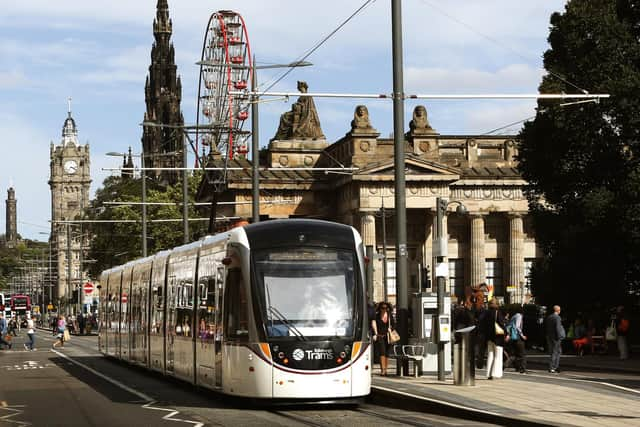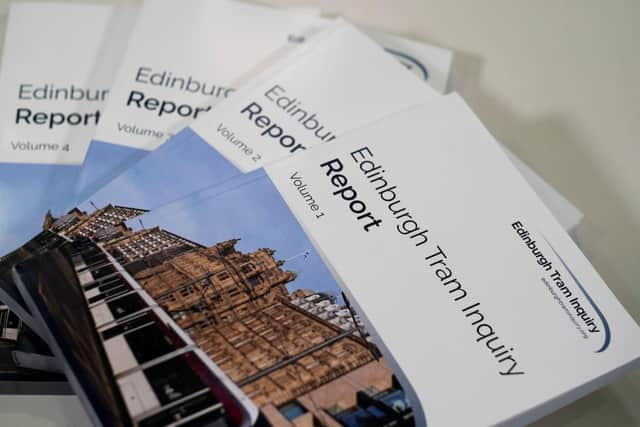Edinburgh Trams Inquiry: The saga that became its own scandal
It made the Nuremberg trials look like an exercise in brevity, boasts more volumes than The Lord of the Rings, and has provided some in Scotland’s legal profession with sufficient remittance as to make early retirement a tempting proposition. But after 3,393 days, over £13 million, and more hold-ups than a Sergio Leone movie, the Edinburgh tram inquiry has finally wheezed its way to the end of the line.
It was on June 5, 2014 that the-then first minister Alex Salmond announced a “swift and thorough inquiry” into the delivery of the Edinburgh trams project to establish the reasons for its delays and cost overruns. What has eventually emerged more than nine years later provides some of those answers, but crucially, it leaves more in the way of questions.
Advertisement
Hide AdAdvertisement
Hide AdChief among them being – what exactly was the point of it all? The inquiry chaired by Lord Hardie was designed to prevent a repeat of the mistakes that plagued the trams project. But just as that endeavour became a source of embarrassment and frustration, the probe itself went off the rails, becoming a scandal in and of itself with a purpose that has long been uncertain.
Consider if you will one of the key terms of reference for the inquiry, which state its findings should recommend how “major tram and light rail infrastructure projects of a similar nature might avoid such failures in future”. The only comparable infrastructure project in sight is the oft-mooted Clyde Metro mass transit scheme and, given the dire state of public finances, it is unlikely that will appear on the horizon any time soon.
Ironically, the only other similar project – a £207m expansion to the very trams scheme the inquiry was set up to interrogate – was approved by the City of Edinburgh four years ago, and the new 2.9-mile link began carrying its first paying passengers earlier this summer, having been delivered on time, on budget, and with comparatively little fuss.
The truth is the moment that expansion was greenlit, with councillors and officials having embarked on their own ‘lesson learning’ journey, Lord Hardie’s inquiry was rendered futile. Yet on it went, at considerable expense to taxpayers. Infamously, the undertaking has taken longer, and cost more, than Sir John Chilcott’s inquiry into the 2003 invasion of Iraq.
In the inquiry’s 959-page report, Lord Hardie spares a few paragraphs to acknowledge the length of time it took him and his team to complete the work. He said Mr Salmond’s phrase “created an expectation in the minds of some that the inquiry would be concluded within a short timescale”. But every inquiry, he pointed out, has its own “particular circumstances” that will impact on its timescale.


In the case of the trams inquiry debacle, those circumstances were extensive and invariably testing, and almost from the get go, it was hampered by delays. Some, such as illness and the advent of a global pandemic, were unavoidable. Others, however, provided ammunition aplenty to those critics who regarded the entire inquiry – which took eight times longer than the construction of the Empire State Building in New York – as a masterclass in well-remunerated incompetence.
A notorious example is the Waverley Gate offices used by the inquiry team. When Lord Hardie first visited the premises in June 2014, they appeared modern and fit for purpose. Although expensive, with the annual rent coming in at £250,000, the space was deemed large enough to handle the demands of the team, and accommodate visitors and members of the press.
But there was one not insignificant problem. It turned out the office’s connectivity to the secure IT network used by the Scottish Government was, in Lord Hardie’s words, “extremely poor”, with disconnections occurring several times a day. Lord Hardie requested a meeting with the Government’s IT officials that July to find a solution, and Vodafone engineers were duly brought in to install a data cabinet in the inquiry office so as to allow for a direct fibre link to the network.
Advertisement
Hide AdAdvertisement
Hide AdThat, at least, was the plan. While the network staff had internal cabling in place by September, there was still no connectivity, meaning members of the inquiry team had to use unreliable mobile broadband connections to do their work. On one occasion, Vodafone engineers attempted to install the new link from St Andrew’s House to the inquiry offices, but were thwarted in their efforts because Scottish Government security officers had not been told they were visiting, and did not grant them access.


On another occasion, in October 2014, Vodafone managed to install the data cabinet and connected it to the internal cabling, but it transpired the firm had not negotiated a wayleave agreement with the building managers, resulting in yet more delays. It was not until that December – some six months after Lord Hardie’s first visit – the inquiry team had reliable computer access.
There were other problems. Lots of them. Security questions were asked after a break-in at the inquiry offices in 2015, and the inquiry’s work was plagued by staff changes. Some of this was down to poor health, but in other cases, there were concerns about conflicts of interest. Lord Hardie’s report makes thinly veiled criticisms of the fact the inquiry had to draw on temporary agency staff to help review documents and take statements, some of whom departed to work on the Scottish Child Abuse Inquiry.
Elsewhere, there were delays in recovering productions from various core participants. It was often necessary to send repeated requests for documents in an effort to obtain them on a voluntary basis without resorting to statutory notices. The City of Edinburgh Council only handed over 16 folders of material and paper bundles after discovering them during a “clear out” of the former office of Dame Sue Bruce, its then chief executive.
So at the end of it all, what, if any, lessons will be learned? Certainly, Lord Hardie’s criticism of then finance secretary John Swinney’s decision to instruct Transport Scotland to “scale back” its involvement with the project is more robust than some expected, and the Scottish Government will come under renewed pressure to justify that course of action.
As things stand, however, ministers seem happy to put the boot into Lord Hardie’s four-volume report. In a withering statement, transport secretary Mairi McAllan concluded his inquiry “took too long, was too costly, and in some instances, the evidence heard does not support the conclusion drawn”.
Such comments will do little to bolster public faith in the inquiry process. It is telling the first recommendation in Lord Hardie’s report was a meta-style rumination on public inquiries themselves, calling for a Government-led review to “determine the most cost-effective method of avoiding delay” in their establishment. Perhaps after that there will be a review into the review of the inquiry? One can never be too thorough, and those KCs won’t pay for themselves.
There are also timing questions surrounding the release of Lord Hardie’s report, which landed on the inquiry’s website on a day when the First Minister was out of the country, and attention was focused on proceedings at the Court of Session over gender reform legislation. There was no press conference to allow public scrutiny of Lord Hardie’s findings or – heaven forbid – questions to be put to the inquiry team.
Advertisement
Hide AdAdvertisement
Hide AdInstead, an email consisting of just three sentences was sent to news desks by a well-remunerated public relations agency alerting them to the report’s release. It gave less than 90 minutes notice of the publication, scheduled for 11am. Unsurprisingly, that deadline was missed by around a quarter of an hour. The report duly arrived alongside a press release and pre-packaged video of Lord Hardie. For a statutory inquiry set up to provide answers to one of modern Scotland’s most bungled public infrastructure projects, it hardly constituted a masterclass in transparency.
So at the end of it all, what are we left with? A monstrously vast bill, widespread mockery, and further erosion of trust in a fundamental democratic process designed to investigate matters of public concern. With the benefit of hindsight, Edinburgh’s civic authorities might have been best advised to bring back horse-drawn coaches. At least there would have been less of a mess to clear up.
Comments
Want to join the conversation? Please or to comment on this article.